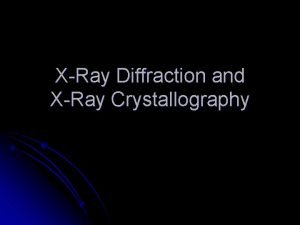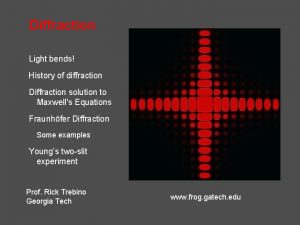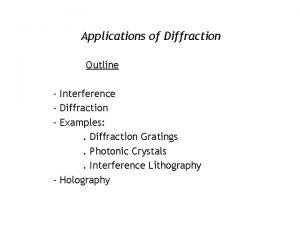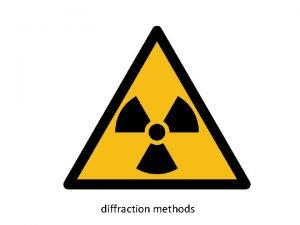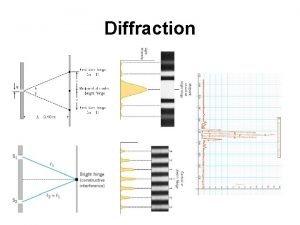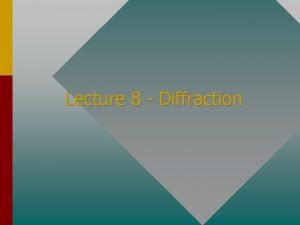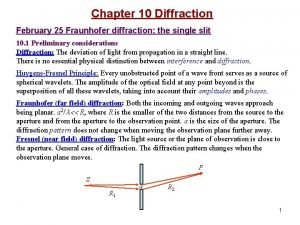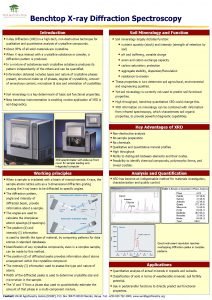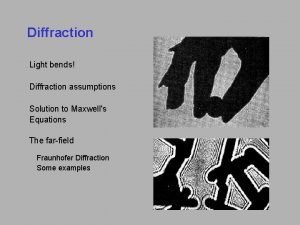27 5 Diffraction 27 5 Diffraction is the












- Slides: 12

27. 5 Diffraction

27. 5 Diffraction is the bending of waves around obstacles or the edges of an opening.

The Amount of Diffraction

Diffraction of Light

Diffraction Minima Dark fringes for single-slit diffraction

Single-slit Diffraction Pattern

EXAMPLE 6: Single-slit Diffraction Light passes through a slit and shines on a flat screen that is located L = 0. 40 m away (see Figure 27. 24). The width of the slit is 4. 0× 10 -6 m. The distance between the middle of the central bright fringe and the first dark fringe is y. Determine the width 2 y of the central bright fringe when the wavelength of the light in a vacuum is (a) l = 690 nm (red) and (b)l = 410 nm (violet).

Example 6, Page 834 Light passes through a slit and shines on a flat screen that is located L = 0. 40 m away (see Figure 27. 24). The width of the slit is 4. 0× 10 -6 m. The distance between the middle of the central bright fringe and the first dark fringe is y. Determine the width 2 y of the central bright fringe when the wavelength of the light in a vacuum is (a) l = 690 nm (red) and (b)l = 410 nm (violet).

27. 6. Resolving Power The resolving power of an optical instrument is its ability to distinguish between two closely spaced objects. Three photographs of an automobile’s headlights taken at progressively greater distances from the camera.

Diffraction from Circular Opening The angle θ, in the picture locates the first circular dark fringe relative to the central bright region and is given by:

Rayleigh criterion It is useful to have a criterion for judging whether two closely spaced objects will be resolved by an optical instrument. Figure 27. 29 a presents the Rayleigh criterion for resolution, first proposed by Lord Rayleigh (1842– 1919): Two point objects are just resolved when the first dark fringe in the diffraction pattern of one falls directly on the central bright fringe in the diffraction pattern of the other.

Example 7 The Human Eye Versus the Eagle’s Eye A hang glider is flying at an altitude of H = 120 m. Green light (wavelength = 555 nm in vacuum) enters the pilot’s eye through a pupil that has a diameter of D = 2. 5 mm. Determine how far apart two point objects must be on the ground if the pilot is to have any hope of distinguishing between them. An eagle’s eye has a pupil with a diameter of D = 6. 2 mm. Repeat part (a) for an eagle flying at the same altitude as the glider.
 Khi nào hổ con có thể sống độc lập
Khi nào hổ con có thể sống độc lập Thế nào là hệ số cao nhất
Thế nào là hệ số cao nhất Các loại đột biến cấu trúc nhiễm sắc thể
Các loại đột biến cấu trúc nhiễm sắc thể Tư thế ngồi viết
Tư thế ngồi viết đặc điểm cơ thể của người tối cổ
đặc điểm cơ thể của người tối cổ Mật thư anh em như thể tay chân
Mật thư anh em như thể tay chân Các châu lục và đại dương trên thế giới
Các châu lục và đại dương trên thế giới Thiếu nhi thế giới liên hoan
Thiếu nhi thế giới liên hoan Chụp phim tư thế worms-breton
Chụp phim tư thế worms-breton Thẻ vin
Thẻ vin Cái miệng nó xinh thế
Cái miệng nó xinh thế Sơ đồ cơ thể người
Sơ đồ cơ thể người












